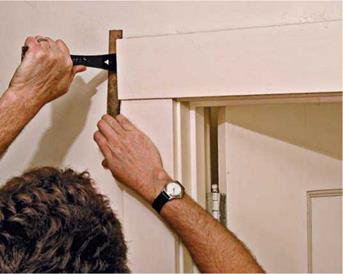CONTAINING THE MESS
Managing mess is crucial to a successful renovation. Torn-out plaster and drywall are nasty stuff to handle and worse to breathe. The dust gets everywhere, and the volume of debris is prodigious. If you’re sloppy as you renovate, you’ll pay later: Finish floors are particularly vulnerable to grit that isn’t swept up and to nails that go astray. Lath with nails sticking out creates a hazardous workplace. Heed these tips and your life will be a lot easier:
► Cover floors with heavy plastic, thick floor-covering cardboard (it comes in rolls), or hardboard panels duct-taped together.
► Isolate the demolition area by duct-taping clear plastic over door and window openings to contain the dust. Clear plastic lets in light.
► Clean up as you tear out.
► When demolishing outside, drape heavy tarps to protect your plants and to avoid a lot of raking later on. After discarding large pieces of debris, two people can lift the tarp and shake the remnants directly into the trash.
Organize your debris. Maximize Dumpster loads by first putting in dense materials such as plaster, concrete, and soil. Place lighter, bulkier items on top. If your community has a recycling center, set aside recyclable materials such as unpainted wood, brick, glass, or metal. That may be cheaper than sending them to a landfill.
Before you construct anything in renovation, it’s usually necessary to tear out part of what’s there and beef up what remains. No sooner have you torn out plaster than you’re nailing up blocking for partitions to come. This natural flow from demolition to construction is a little frustrating for how-to writers who like to pigeonhole everything, but it’s a fact of life if you’re renovating. Frequently, you’re doing both at the same time.


 Conserve when you can. If most of a plaster surface is sound, avoid damaging adjacent areas when removing loose plaster, exposing framing, or adding openings. For example, if you’re adding a medicine cabinet, set your circular-saw blade to the depth of the old plaster and lath, and cut back those materials to the nearest stud centers on both sides so the plaster edges can be renailed before you patch the opening.
Conserve when you can. If most of a plaster surface is sound, avoid damaging adjacent areas when removing loose plaster, exposing framing, or adding openings. For example, if you’re adding a medicine cabinet, set your circular-saw blade to the depth of the old plaster and lath, and cut back those materials to the nearest stud centers on both sides so the plaster edges can be renailed before you patch the opening.
On the other hand, if at least half of a room is to be affected by demo or if the existing plaster walls are cracked and damaged, it is often better to gut the room. When wires, pipes, framing, and rotted areas are exposed, new framing and dry – wall go in faster and finish better. It’s tough and time-consuming to patch extensively.






Leave a reply